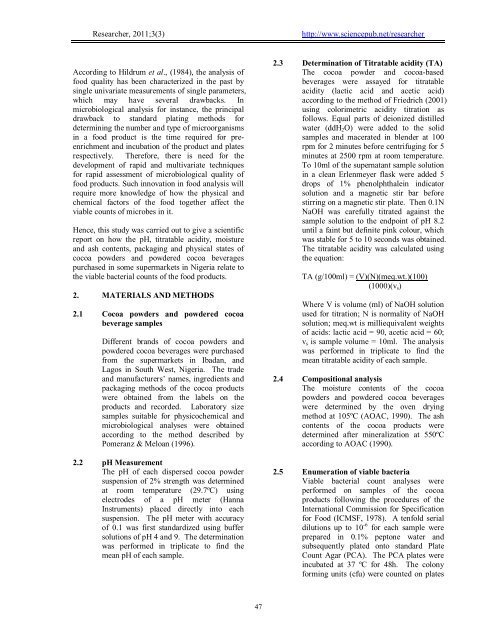Download (47Kb) - Covenant University Repository
Download (47Kb) - Covenant University Repository
Download (47Kb) - Covenant University Repository
You also want an ePaper? Increase the reach of your titles
YUMPU automatically turns print PDFs into web optimized ePapers that Google loves.
Researcher, 2011;3(3) http://www.sciencepub.net/researcher<br />
According to Hildrum et al., (1984), the analysis of<br />
food quality has been characterized in the past by<br />
single univariate measurements of single parameters,<br />
which may have several drawbacks. In<br />
microbiological analysis for instance, the principal<br />
drawback to standard plating methods for<br />
determining the number and type of microorganisms<br />
in a food product is the time required for preenrichment<br />
and incubation of the product and plates<br />
respectively. Therefore, there is need for the<br />
development of rapid and multivariate techniques<br />
for rapid assessment of microbiological quality of<br />
food products. Such innovation in food analysis will<br />
require more knowledge of how the physical and<br />
chemical factors of the food together affect the<br />
viable counts of microbes in it.<br />
Hence, this study was carried out to give a scientific<br />
report on how the pH, titratable acidity, moisture<br />
and ash contents, packaging and physical states of<br />
cocoa powders and powdered cocoa beverages<br />
purchased in some supermarkets in Nigeria relate to<br />
the viable bacterial counts of the food products.<br />
2. MATERIALS AND METHODS<br />
2.1 Cocoa powders and powdered cocoa<br />
beverage samples<br />
Different brands of cocoa powders and<br />
powdered cocoa beverages were purchased<br />
from the supermarkets in Ibadan, and<br />
Lagos in South West, Nigeria. The trade<br />
and manufacturers’ names, ingredients and<br />
packaging methods of the cocoa products<br />
were obtained from the labels on the<br />
products and recorded. Laboratory size<br />
samples suitable for physicochemical and<br />
microbiological analyses were obtained<br />
according to the method described by<br />
Pomeranz & Meloan (1996).<br />
2.2 pH Measurement<br />
The pH of each dispersed cocoa powder<br />
suspension of 2% strength was determined<br />
at room temperature (29.7ºC) using<br />
electrodes of a pH meter (Hanna<br />
Instruments) placed directly into each<br />
suspension. The pH meter with accuracy<br />
of 0.1 was first standardized using buffer<br />
solutions of pH 4 and 9. The determination<br />
was performed in triplicate to find the<br />
mean pH of each sample.<br />
47<br />
2.3 Determination of Titratable acidity (TA)<br />
The cocoa powder and cocoa-based<br />
beverages were assayed for titratable<br />
acidity (lactic acid and acetic acid)<br />
according to the method of Friedrich (2001)<br />
using colorimetric acidity titration as<br />
follows. Equal parts of deionized distilled<br />
water (ddH2O) were added to the solid<br />
samples and macerated in blender at 100<br />
rpm for 2 minutes before centrifuging for 5<br />
minutes at 2500 rpm at room temperature.<br />
To 10ml of the supernatant sample solution<br />
in a clean Erlenmeyer flask were added 5<br />
drops of 1% phenolphthalein indicator<br />
solution and a magnetic stir bar before<br />
stirring on a magnetic stir plate. Then 0.1N<br />
NaOH was carefully titrated against the<br />
sample solution to the endpoint of pH 8.2<br />
until a faint but definite pink colour, which<br />
was stable for 5 to 10 seconds was obtained.<br />
The titratable acidity was calculated using<br />
the equation:<br />
TA (g/100ml) = (V)(N)(meq.wt.)(100)<br />
(1000)(vs)<br />
Where V is volume (ml) of NaOH solution<br />
used for titration; N is normality of NaOH<br />
solution; meq.wt is milliequivalent weights<br />
of acids: lactic acid = 90, acetic acid = 60;<br />
vs is sample volume = 10ml. The analysis<br />
was performed in triplicate to find the<br />
mean titratable acidity of each sample.<br />
2.4 Compositional analysis<br />
The moisture contents of the cocoa<br />
powders and powdered cocoa beverages<br />
were determined by the oven drying<br />
method at 105ºC (AOAC, 1990). The ash<br />
contents of the cocoa products were<br />
determined after mineralization at 550ºC<br />
according to AOAC (1990).<br />
2.5 Enumeration of viable bacteria<br />
Viable bacterial count analyses were<br />
performed on samples of the cocoa<br />
products following the procedures of the<br />
International Commission for Specification<br />
for Food (ICMSF, 1978). A tenfold serial<br />
dilutions up to 10 -6 for each sample were<br />
prepared in 0.1% peptone water and<br />
subsequently plated onto standard Plate<br />
Count Agar (PCA). The PCA plates were<br />
incubated at 37 ºC for 48h. The colony<br />
forming units (cfu) were counted on plates
















